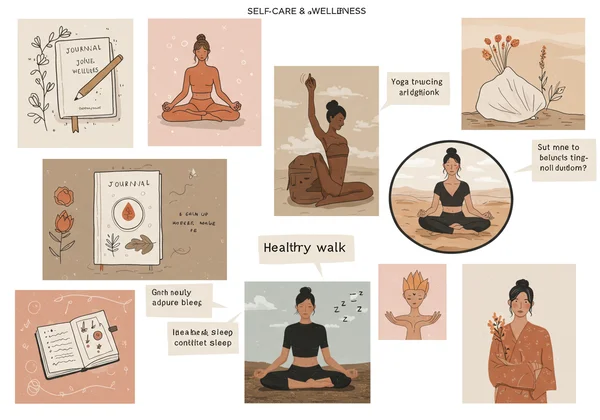Build Your Bipolar Support System After BSDS Screening
Receiving your Bipolar Spectrum Diagnostic Scale (BSDS) screening results can bring a mix of emotions—relief, confusion, or even anxiety. You might be asking yourself, what comes next after a BSDS screening? Taking that first step toward understanding your mental health is a courageous act, and you don't have to navigate the path forward alone. Building a strong, compassionate support system is one of the most powerful steps you can take on your mental health journey.
This guide is designed to help you understand how to build that network. We'll walk through practical strategies for processing your feelings, communicating your needs, and finding resources that empower you. Your results from your BSDS assessment are not an endpoint; they are a starting point for gaining clarity and finding the right support.
Acknowledge & Process Your Feelings After Your BSDS Results
Before you can build a support system, it's essential to give yourself the space to understand your own feelings. After completing a screening, it's completely normal to feel a wave of different emotions. There is no right or wrong way to feel. The key is to acknowledge these feelings without judgment, as this is a crucial first step toward finding mental health support.
Taking a moment for self-reflection can provide a solid foundation for the conversations you will have later. This period is about you and what you need to feel grounded. Remember, a screening result is just a piece of information, and the BSDS self-assessment is designed to be a tool for awareness, not a label.
Understanding Initial Reactions to a Potential Bipolar Screening
It's common to feel overwhelmed when faced with information that suggests you may have bipolar spectrum traits. Some people feel a sense of validation, as it might finally put a name to experiences they've struggled to understand. Others may feel scared or uncertain about the future. All these reactions are valid. Recognize that this information doesn't change who you are; it simply offers a new lens through which to understand your experiences with mood and energy.
Giving Yourself Time to Absorb the Information
Allow yourself time for emotional processing. You don't need to have all the answers or an immediate action plan. Rushing can lead to more stress. Instead, take a day or two to sit with the information. You might find it helpful to write down your thoughts in a journal, go for a walk in nature, or engage in a calming activity you enjoy. This quiet time can help you approach the next steps with a clearer mind.

Identify Your Trusted Circle: Who to Tell About Your Bipolar Journey
Deciding who to share your experience with is a deeply personal choice. The goal is to build a circle of trust with people who will offer encouragement and understanding. Telling family about mental health can be daunting, but opening up to the right people can make a world of difference. Your support system doesn't need to be large; a few reliable and empathetic individuals are more valuable than a large group that doesn't understand.
Think about the people in your life who have shown themselves to be good listeners, non-judgmental, and trustworthy. These are the individuals who will likely form the core of your support network as you continue understanding your results.
Choosing Your Confidantes: Friends, Family, or Mentors
Your trusted circle could include a close friend, a supportive family member, a partner, or even a mentor. When deciding who to talk to, consider these questions: Do they respect your privacy? Have they been supportive during difficult times in the past? Do they listen more than they lecture? You are in control of who you let into your journey. Start with one person you trust completely.
Why Open Communication is Key for Mental Health Support
Keeping feelings bottled up can lead to isolation. Open communication with trusted individuals helps break down that isolation. Sharing your experience can lift a heavy weight off your shoulders and allow others to offer the practical and emotional support you need. It also helps them understand your behaviors, especially concerning mood shifts, which can strengthen your relationships in the long run.

Communicate Effectively: Sharing Your BSDS Screening Experience
Once you've identified who you want to talk to, the next step is figuring out how to have that conversation. How to talk to a friend about mental health? Preparing a little beforehand can help the discussion go more smoothly and ensure you get the support you need. Remember, your goal is to share your experience and let them know how they can help.
This isn't about having a perfect conversation. It's about being honest and open in a way that feels safe for you. The insights from your BSDS screening can serve as a concrete starting point to start the conversation about what you've been experiencing.
Preparing for Conversations About Your Mood & BSDS Findings
Before you talk, think about what you want to share. You might say something like, "I recently took an online screening for bipolar spectrum traits because I've been struggling with my mood shifts, and the results suggested it's something I should look into with a doctor." Using "I" statements keeps the focus on your experience. You can also think about what you might need from them, such as simply listening or helping you find a healthcare professional.
Setting Healthy Boundaries and Managing Reactions
Not everyone will react in the way you hope, and that's okay. Some people may be confused or say the wrong thing because they lack understanding. It's important to set healthy boundaries. You can say, "I appreciate your concern, but right now, I just need you to listen." You are not responsible for managing their emotions. The purpose of this conversation is to get support for yourself.
Explore Formal Support: Groups and Professional Resources
In addition to personal relationships, formal support systems can provide invaluable resources and community. Seeking bipolar disorder support from professionals and peer groups connects you with people who have specialized knowledge and lived experience. These resources can complement the support you receive from friends and family.
Remember, the goal of a tool like the free bipolar test is to empower you with information to take the next step, which almost always involves consulting with a professional.
Benefits of Bipolar Support Groups and Communities
Joining support groups—either online or in-person—can be incredibly validating. Hearing from others who have similar experiences helps combat feelings of isolation and reduces stigma. In these communities, you can share coping strategies, celebrate successes, and find encouragement during challenging times. Organizations like the Depression and Bipolar Support Alliance (DBSA) offer excellent resources for finding local or online groups.

Navigating Online Forums and Mental Health Organizations
Many reputable mental health organizations provide accurate information, resources, and online forums. When exploring online communities, make sure they are moderated and come from trusted sources like national health institutes or non-profits. These platforms can be a great way to ask questions and learn from a wider community, but always verify medical information with a qualified professional.
Nurturing Your Well-being: Prioritizing Self-Care
Your most important supporter is yourself. Building a bipolar support system also means creating internal systems of self-care and compassion. Prioritizing your well-being is not selfish; it's a fundamental part of managing your mental health effectively. Self-care involves intentional actions you take to care for your physical, mental, and emotional health.
Think of self-care as the foundation upon which your entire support network rests. The information you gained from the BSDS online test can help you identify areas where self-care might be particularly beneficial.
Integrating Daily Wellness Practices into Your Routine
Simple wellness practices can have a significant impact on your mood and energy levels. This could include establishing a consistent sleep schedule, incorporating gentle movement or exercise into your day, practicing mindfulness or meditation for a few minutes, or keeping a mood journal to track your feelings. Consistency is more important than intensity. Find small, sustainable habits that you can build on over time.
The Link Between Self-Care and Managing Mood Shifts
There is a direct connection between self-care and emotional regulation. A consistent routine, a healthy diet, and regular exercise can help stabilize mood and energy levels. For example, lack of sleep can be a major trigger for mood episodes. By prioritizing these foundational self-care practices, you are actively participating in your own well-being and creating a more stable internal environment.

Embracing a Supported Path Forward
Your BSDS screening results mark a pivotal step in your journey toward understanding and empowerment. As you acknowledge your feelings, carefully choose confidantes, communicate effectively, explore formal resources, and prioritize self-care, you actively build a robust support system around you. You are not defined by a screening result, but you can be empowered by the knowledge it provides. This is your opportunity to build a life filled with understanding, compassion, and the right support. Use this moment as a catalyst for positive change. Your path forward is one of hope, and you have the tools and the strength to walk it. To learn more or revisit the screening, start your journey on our homepage.
Frequently Asked Questions About Bipolar Support & BSDS
Is the BSDS a definitive diagnosis for bipolar disorder?
No, absolutely not. The Bipolar Spectrum Diagnostic Scale (BSDS) is a scientifically validated screening tool designed to help identify traits associated with bipolar spectrum disorder. It is an excellent starting point for self-awareness and for facilitating a conversation with a healthcare provider. Only a qualified medical or mental health professional, like a psychiatrist or psychologist, can provide a definitive diagnosis after a comprehensive evaluation. The BSDS screening tool is meant to be the first step, not the last word.
What are the signs of bipolar disorder I should discuss with my support system?
When talking to your support system, it can be helpful to describe your experiences rather than using clinical labels. You can talk about periods of unusually high energy, racing thoughts, and decreased need for sleep (mania or hypomania). You can also discuss periods of deep sadness, low energy, and loss of interest in activities (depression). Sharing specific examples of how these mood shifts impact your daily life can help them understand what you're going through.
How accurate is the BSDS test in identifying bipolar spectrum traits?
The BSDS is a well-researched and validated instrument used in both clinical and research settings to screen for bipolar spectrum characteristics. It has demonstrated good accuracy in identifying individuals who may benefit from a further, more detailed clinical assessment. However, its accuracy depends on honest self-reporting, and like any screening tool, it is not 100% perfect and should not replace a professional clinical interview.
What is the Bipolar Spectrum Diagnostic Scale (BSDS)?
The Bipolar Spectrum Diagnostic Scale (BSDS) is a self-assessment questionnaire developed by Dr. Ronald Pies to help identify symptoms and behaviors associated with the full spectrum of bipolar disorder, including less obvious forms. It consists of a story followed by a series of questions that ask you to reflect on your life experiences related to mood, energy, and behavior. The BSDS test is a valuable tool for raising awareness and gathering information to share with a doctor.